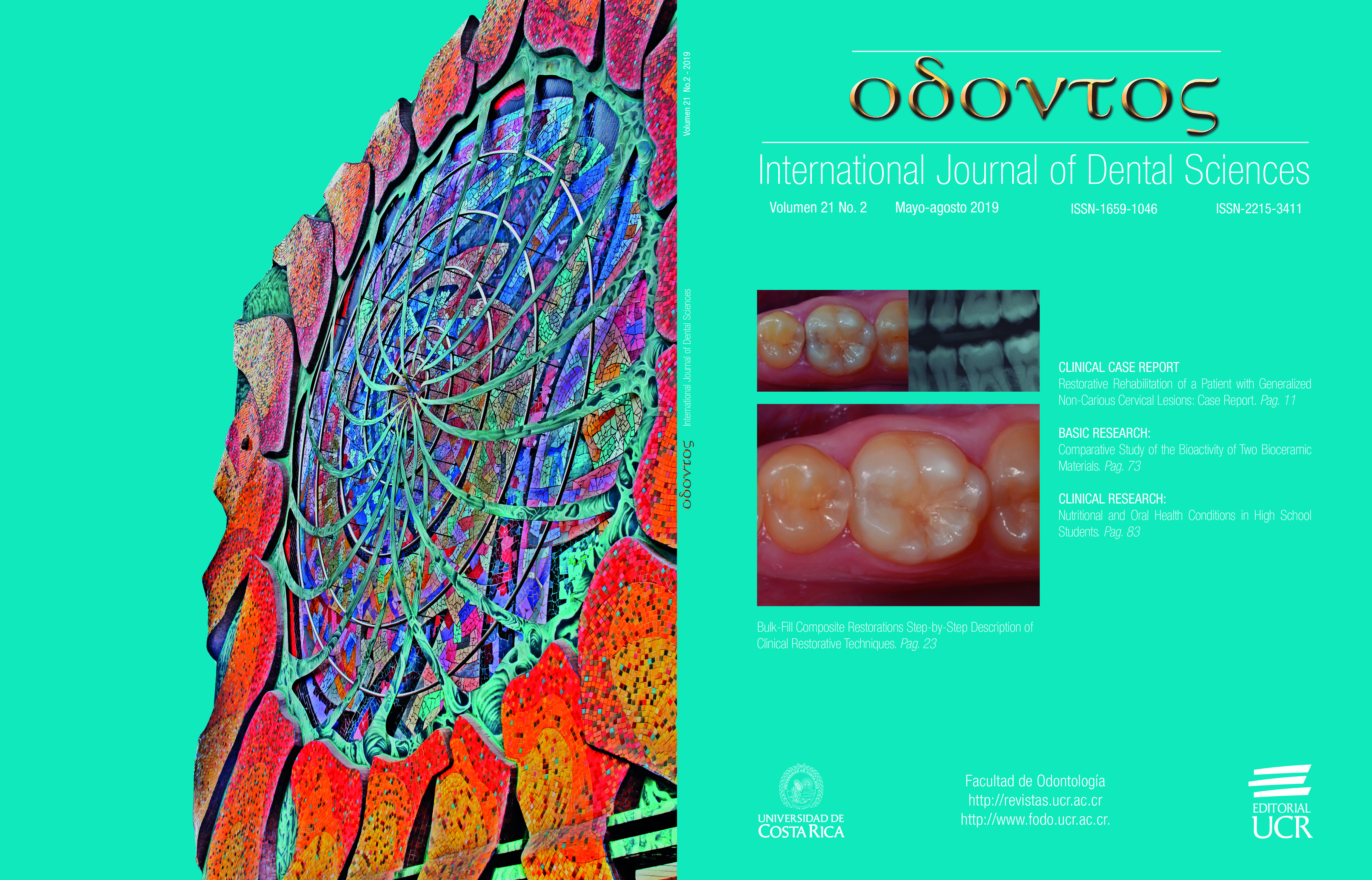Resumen
Las lesiones cervicales no cariosas (LCNC) son una problemática actual de origen multifactorial, la cual se ve asociada a la pérdida de dimensión vertical oclusal, hipersensibilidad, pérdida de dientes, fracturas y muchas otras patologías que afectan la función masticatoria de la cavidad bucal. La identificación de los factores etiológicos de las LCNC son piezas claves para la solución del problema. Basados en la evidencia científica clínica relacionado con el diagnóstico, se debe planificar un plan de tratamiento restaurativo que depende de la pérdida de la estructura dentaria para devolver la función y estética. El objetivo de este reporte de caso es describir a un paciente masculino de 54 años a quien se le diagnosticó LCNC generalizadas combinado con una pérdida de dimensión vertical oclusal. El protocolo de plan de tratamiento es descrito paso a paso.
Citas
Aw T. C., Lepe X., Johnson G. H., Mancl L. Characteristics of noncarious cervical lesions: a clinical investigation. J Am Dent Assoc 2002; 133 (6): 725-733.
Que K., Ruan J., Fan X., Liang X., Hu D. A multi-centre and cross-sectional study of dentine hypersensitivity in China. J Clin Periodontol 2010; 37 (7): 631-637.
Wood I., Jawad Z., Paisley C., Brunton P. Non-carious cervical tooth surface loss: a literature review. J Dent 2008; 36 (10): 759-66.
Scherman A., Jacobsen P. L. Managing dentin hypersensitivity: what treatment to recommend to patients. J Am Dent Assoc 1992; 123 (4): 57-61.
Lussi A., Schlueter N., Rakhmatullina E,. Ganss C. Dental erosion--an overview with emphasis on chemical and histopathological aspects. Caries Res 2011; 45 Suppl 1:2-12.
Shellis R. P., Addy M. The interactions between attrition, abrasion and erosion in tooth wear. Monogr Oral Sci 2014; 25: 32-45.
Coy G. Mc. The etiology of gingival erosion J Oral Implantol 1982; 10 (3): 361-262.
Grippo J. O., Simring M. Dental erosion revisted, J Am Dent Assoc 1995; 126 (5) : 619-628.
Grippo J. O., Simring M., Schreiner S. Attrition, abrasion, corrosion and abfraction revisited: a new persective on tooth surface lesions. J Am Dent Assoc 2004; 135 (8): 1109-18.
Lee W. C., Eakle W. S. Stress-induced cervical lesions: review of advances in the past 10 years. J Prosthet Dent 1996; 75 (5) : 487-494.
Tomasik M. Analysis of etiological factors involved in noncarious cervical lesions. Ann Acad Med Stetin 2006; 52 (3) : 125-136.
Moretto S. G., Russo E. M., Carvalho R. C., De Munck J., Van Landuyt K., Peumans M., Van Meerbeek B., Cardoso M. V. 3-year clinical effectiveness of one-step adhesives in non-carious cervical lesions. J Dent 2013; 41 (8): 675-82.
van Dijken J. W. A randomized controlled 5-year prospective study of two HEMA-free adhesives, a 1-step self etching and a 3-step etch-and-rinse, in non-carious cervical lesions. Dent Mater 2013; 29 (11): e271-280.
Guldag M. U., Buyukkaplan U. S., Ay Z. Y., Katirci G. A multidisciplinary approach to dental erosion: a case report. Eur J Dent 2008; 2 (2): 110-4.
West N., Seong J., Davies M. Dentine hypersensitivity. Monogr Oral Sci 2014; 25: 108-122.
Yang S., Lee H., Jin S. H. A combined approach to non-carious cervical lesions associated with gingival recession. Restor Dent Endod 2016; 41 (3): 218-224.
Que K., Guo B., Jia Z., Chen Z., Yang J., Gao P. A cross-sectional study: non-carious cervical lesions, cervical dentine hypersensitivity and related risk factors. J Oral Rehabil 2013; 40 (1): 24-32.
Zucchelli G., Gori G., Mele M., Stefanini M., Mazzotti C., Marzadori M., Montebugnoli L., De Sanctis M. Non-carious cervical lesions associated with gingival recessions: a decision-making process. J Periodontol 2011; 82 (12): 1713-1724.
Heasman P. A., Holliday R., Bryant A., Preshaw P. M. Evidence for the occurrence of gingival recession and non-carious cervical lesions as a consequence of traumatic toothbrushing. J Clin Periodontol 2015; 42 Suppl 16: S237-55.
Schuyler C. H. The function and importance of incisal guidance in oral rehabilitation. J Prosthet Dent 2001; 86 (3): 219-232.
AlShahrani M. T., Haralur S. B., Alqarni M. Restorative Rehabilitation of a Patient with Dental Erosion. Case Rep Dent 2017; 9517486.
Chana H., Kelleher M., Briggs P., Hooper R. Clinical evaluation of resin-bonded gold alloy veneers. J Prosthet Dent 2000; 83 (3): 294-300.
Owens B. M. The potential efects of pH and bufering capacity on dental erosion. Gen Dent 2007; 55 (6): 527-531.
West N. X., Hughes J. A., Addy M. The effect of pH on the erosion of dentine and enamel by dietary acids in vitro. J Oral Rehabil 2001; 28 (9): 860-864.

